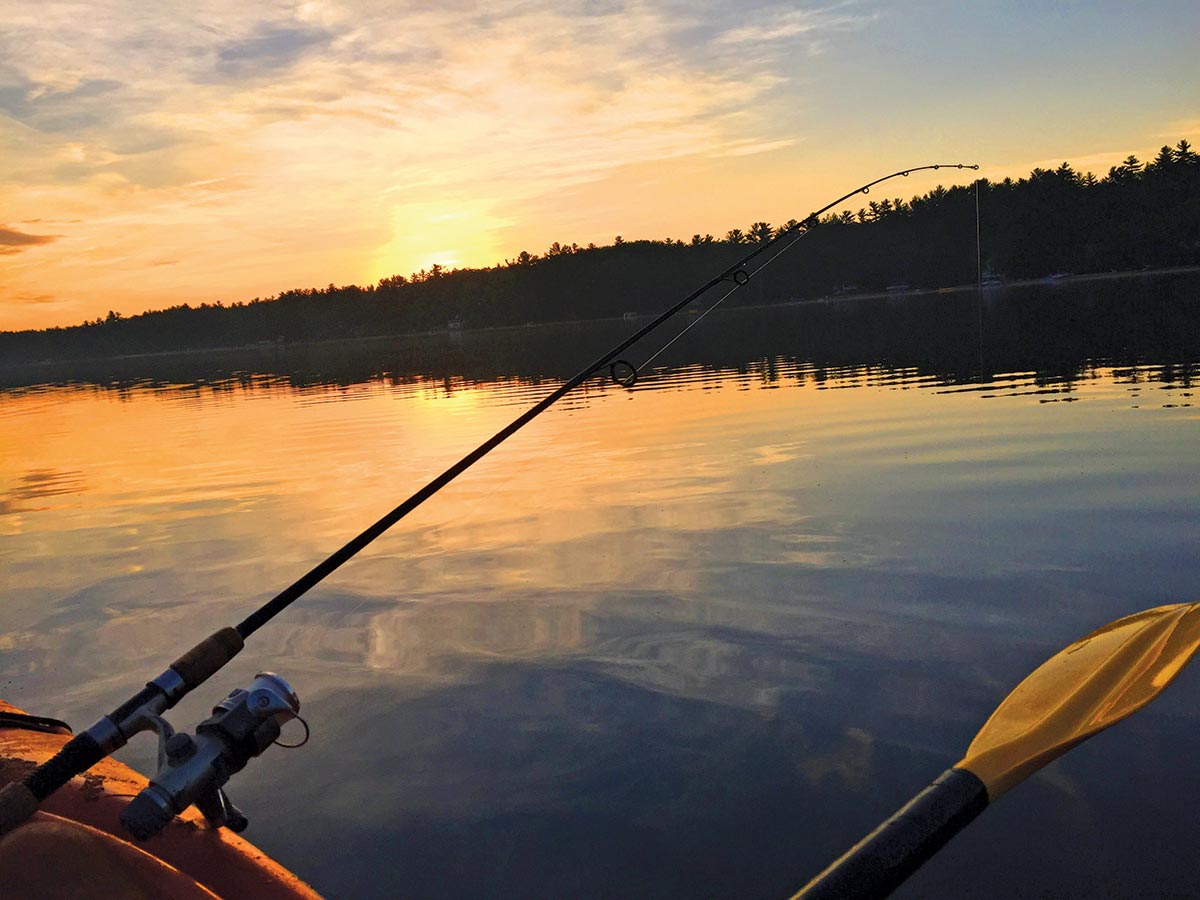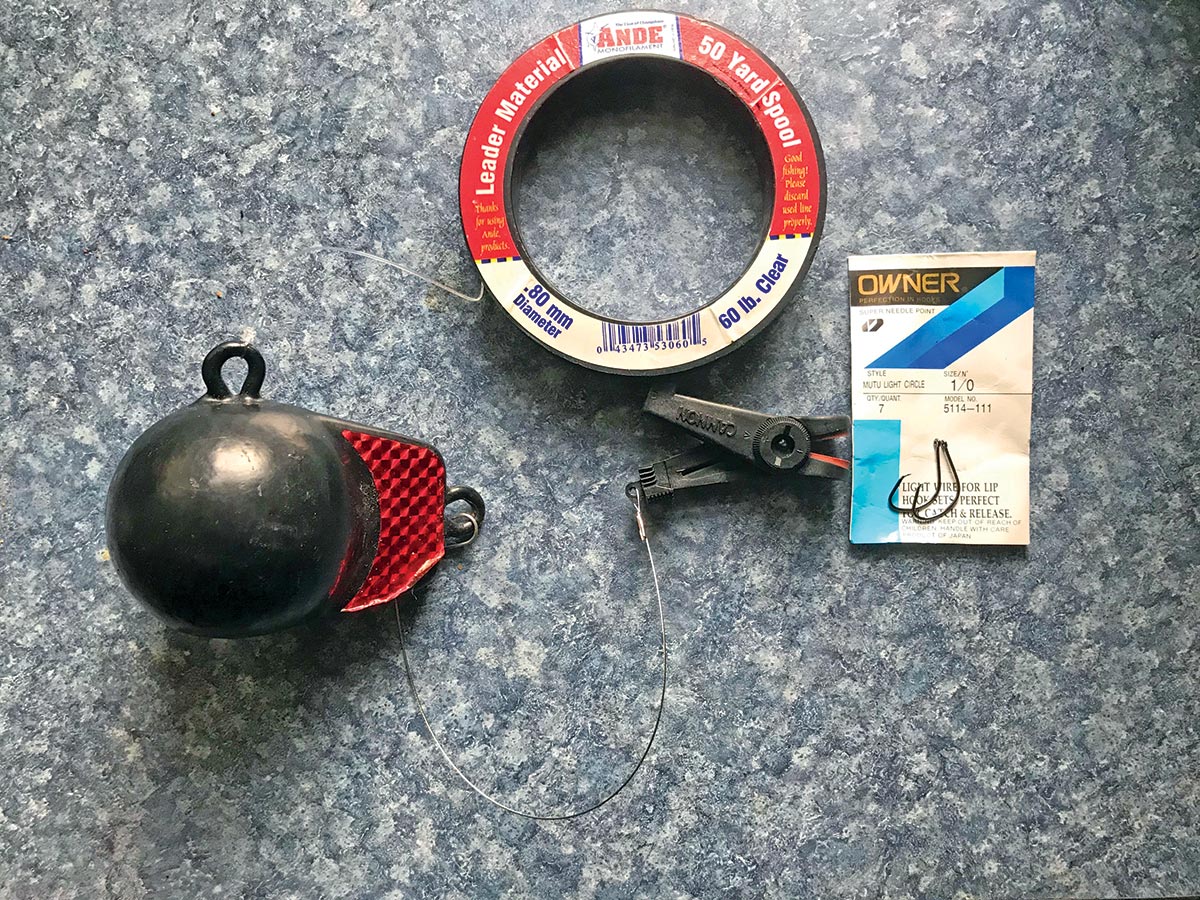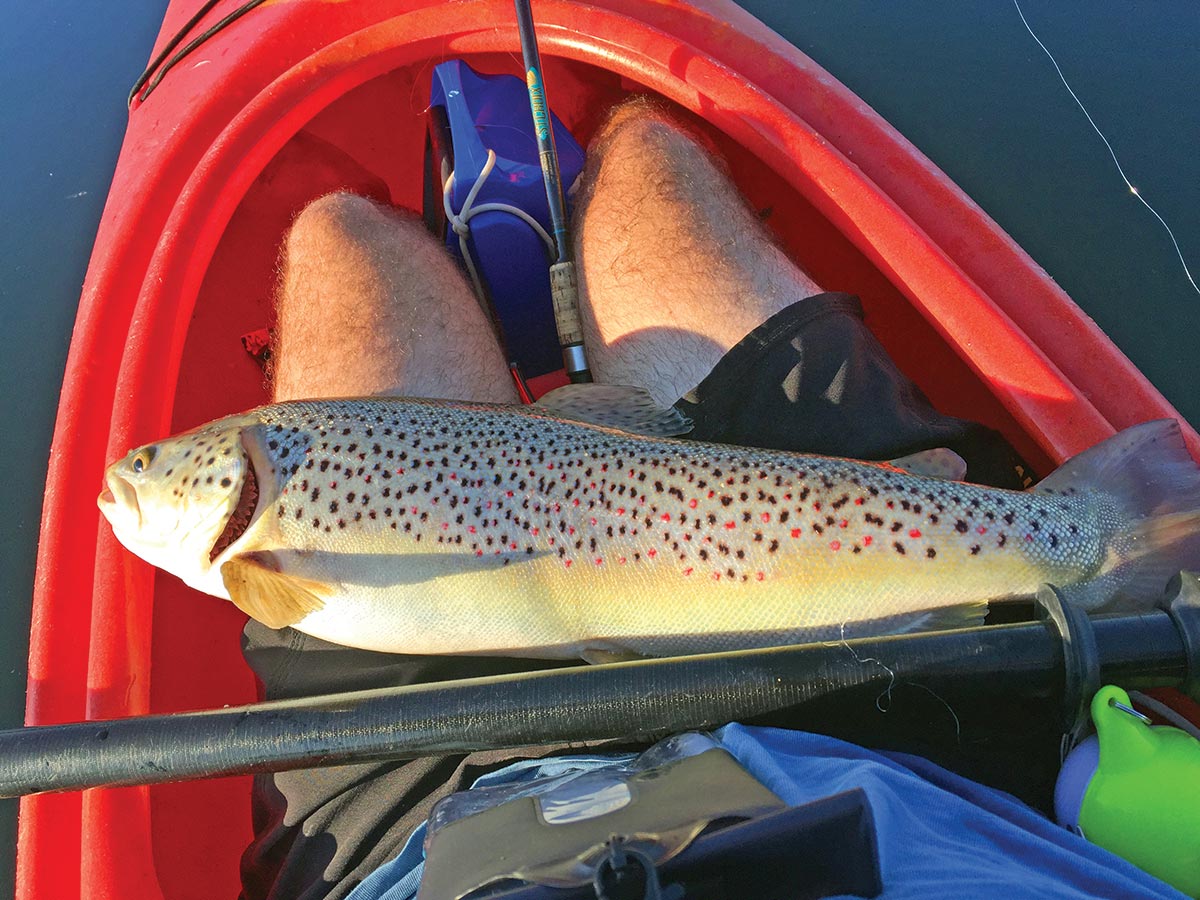
A simple yet effective way to target large, summertime trout from a kayak.
For the past 11 years I have been visiting the same lake in southern Maine with my now wife and her amazing family of what I call “normal people.” Normal people are able to go on vacation and relax, sit by the lake, read a book, or even sleep in, but are not consumed with a compulsion to investigate every point, cove, bay, rock pile, and drop-off in a lake and how fish may relate to them. Normal people do not get up at 1:30 AM to go check out the splashing fish that can be heard through the open window. Normal people don’t paddle 2-plus miles in a kayak at 5AM just to check out a weed line they saw on satellite imagery.
On my first few summer visits the focus was mainly on bass fishing and learning the lake, and after slogging through a learning curve I began to have some consistent success. I primarily fished from a kayak and really enjoyed the minimalist and stealthy platform it provided. However, despite my success with the bass, the specter of the lake’s oversized brown trout loomed large, and no place larger than the local breakfast restaurant where mammoth brown trout mounts hung from the wall as a tangible reminder of what was swimming unseen beneath my kayak. Growing up in coastal Connecticut, the pursuit of trout was mainly a spring time endeavor and something to do until the local saltwater fishing fired up. The thought of targeting trout in the middle of summer was a foreign concept, especially given trout’s preference for cooler water.
As the years wore on, and my familiarity with the lake grew, I couldn’t stare at the big trout taunting me at breakfast any longer. I began to experiment with a variety of techniques and found that slow trolling live shiners from the kayak at specific depths using a downrigger ball was a real winner. All of my biggest browns have come using this method, and it has really become one of the highlights of my summer. This technique could not be any simpler and can be applied at similar lakes across New England and beyond.
Thermocline and Depth
The biggest adjustment to this style of fishing was understanding that it was not structure based, but rather an open-water fishery centered on water temperature, oxygen content, and schools of alewife. During the summer deep lakes will thermally stratify into layers of different water temperature. These distinct layers form due to the differences in density between warm and cold water; the denser cold water sinks to the bottom of the lake while the warmer water “floats” near the surface. The surface layer is warm and oxygen rich but is generally too warm in the summer for cold-water trout species; this layer of the lake is known as the epilimnion. Beneath this layer is the hypolimnion, a deeper cold layer of water that under some conditions can become extremely oxygen poor, particularly in deep areas that are isolated from the wind mixing and photosynthesis at the surface, which provide oxygen to the lake. Between these two layers is what is known as the thermocline, an area of rapid change in temperature where the epilimnion and hypolimnion meet, and most importantly to trout fishermen offers a “sweet spot” of temperature and dissolved oxygen where trout can be found during summer months.
The exact location of the thermocline varies from lake to lake and even throughout the course of the day. The important thing to remember is that fish will move outside of it if a good feeding opportunity presents itself, but it is in your best interest to fish in close proximity to it. On the lake I fish, I usually try and set my baits from 15 to 25 feet down; for reference the maximum depth in this lake is around 45 feet.

You can identify the thermocline in a variety of ways, the most accurate is to get a temperature probe that can be lowered to known depths and read out temperatures at the surface. If there is a lake association at your lake there is a chance that they may publish information about the depth of the thermocline based on regular water quality monitoring. Another option, which is perhaps the most hands-on, is to take a swim and dive down until you hit the cold water, while kind of an extreme example, nothing will demonstrate the concept of a thermocline better than swimming into a wall of chilly water as there will be no doubt when you have hit the thermocline. You can also turn up the gain on your fishfinder, and the thermocline can be spotted as a somewhat solid line at a specific depth. Finally, and perhaps the easiest method of all, is to just ask the guys at the nearest bait shop. Targeting the thermocline greatly narrows down the amount of water you need to target.
Once you locate the thermocline, the next step is to find the fish within that volume of water. Many lakes in New England are home to populations of land-locked alewife; these schooling baitfish are a prime forage item for large brown trout and other freshwater predators. When suspended in the water column alewife schools can be found on fishfinders. Early in the morning and just before sundown alewife schools can also be spotted flipping and pushing water just below the surface. Fishing beneath and around these schools of baitfish are great way to target large brown trout.
Technique and Rigging
This technique is about as straightforward as it gets: slowly troll a live shiner at or just above the thermocline. I typically use common or golden shiners in the 3- to 6-inch range, and they can be found at most bait shops or jigged up on small trout flies or tiny hooks tipped with a piece of worm or Gulp. While a 6-inch shiner might seem like a large bait, I have taken trout to 6 pounds using this method and trout in excess of 20 pounds have come from this lake. A large bait is exactly what these slob trout are looking for!
Keeping your bait in the strike zone around the thermocline is the most important part of this presentation. The use of downriggers is one of the most effective ways to control the depth of trolled baits, but downrigger set-ups on boats can be both bulky and expensive. Since I was fishing on a kayak, I wanted a small and portable system so I tied a 4-pound downrigger ball to a coil of 60-pound leader material from my surf bag, and for around $30 had a downrigger system I could hold in one hand. A clip attached to the downrigger ball clamps on to your running line. As the weighted ball is lowered to depth the clip brings your line and bait along for the ride and holds it at your target depth as you slowly paddle around the lake. I typically paddle around 0.5 mph or less.

When a fish hits the added resistance usually pops your line free from the clip and then the fight is on. However, the line does not always release from the clip so it is important to pay constant attention to your rod tip. On several occasions I noticed my rod tip starting to bounce or load up without my line releasing from the clip, when this happens I reel down tight and gently lift until my line pops free from the clip. When setting a bait I cast it out as far as I can behind the kayak, then attach the running line to the clip and lower it to my target depth. Before I start paddling I reel down fairly tight to the downrigger ball so that any additional pressure from a fish will pop my line and allow me to freely fight the fish.
My rig consists of a small to medium-sized octopus or circle hook attached to 8-pound test fluorocarbon leader connected to 6-pound test mono via a small barrel swivel. I feel the small swivel helps reduce any line twist during trolling or retrieving baits and offers a more secure leader connection when using the lighter lines. I use the same rod I use for bass fishing, a 6’6’’ St. Croix premier rated for 6- to 10-pound line.
I have had the most success very early in the morning, from first light until maybe 7 AM. Boat traffic at this time of day is minimal while all those “normal people” sleep in, so schools of baitfish can be identified and the trout are not spooked. The trout also seem to be much more active at this time of day.
If you have the trout bug or are looking to try something new this summer, go deep, go early, and go slow and you just might meet up with the biggest trout you never knew was there.




